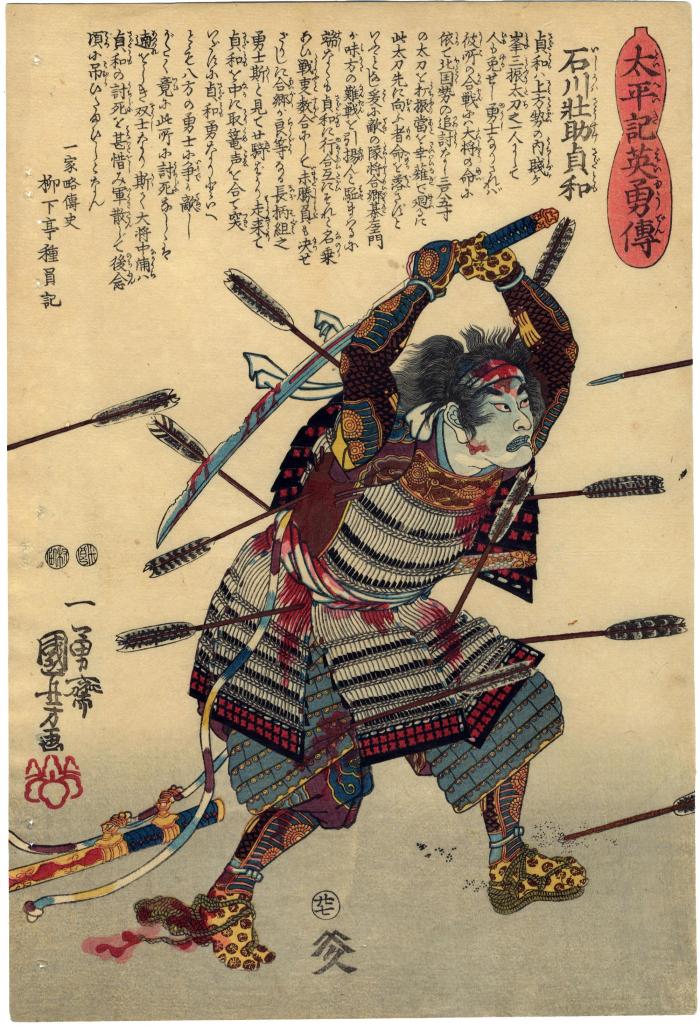Utagawa Kuniyoshi (歌川国芳) (artist 11/15/1797 – 03/05/1861)
Ishikawa Sōsuke Sadatomo (石川荘助貞和), #27 from the series Heroes of the Great Peace (Taiheiki eiyūden - 太平記英勇傳)
ca 1848 – 1849
9.875 in x 14.5 in (Overall dimensions) Japanese woodblock print
Signed: Ichiyūsai Kuniyoshi ga
一勇斎国芳画
Artist's seal: kiri
Publisher: Yamamotoya Heikichi
(Marks 595 - seal 04-007)
Censor seals: Mera and Murata
Number 27: 廿七
Text: Ryūkatei Tanekazu (柳下亭種員)
Art Gallery of Greater Victoria
Legion of Honor
Tokyo Metropolitan Library
Museum für Ostasiatische Kunst, Köln
Museum of Oriental Art, Venice (via Ritsumeikan University) The historical Ishikawa Hyōsuke Kazumitsu, 1565?-1583.
****
In an essay posted by a faculty member of the Rhode Island School of Design it says:
Texts on the prints contain mentions and descriptions of traditional elements of warfare [6].One of them is nanori, or self-introduction made by a warrior on the battlefield. Nanori along with the personal name of the warrior could include indication of his age, title, position, declaration of genealogy, enumeration of heroic deeds performed by the warrior himself or his ancestors. Thus a warrior defined himself for the enemy while looking for a worthy opponent for a fight, which implied someone equal in title and position. By announcing his name the warrior attempted to intimidate his adversary emerging as a representative of the former deserts of his clan. He also hoped to add to the fame of his family, not to mention securing an eyewitness of his deeds necessary for claiming reward for the service [7]. Nanori is mentioned in the texts of the studied series twice. The story on the print Ishikawa Sōsuke Sadatomo contains the phrase “they both announced their names and clashed;” similar sentence we read in the text on the print Shiōren Sazima-no kami Masataka: “They both announced their names and grappled.”The bold type is our choice. Footnotes 6 and 7 refer to Varley, P. Warriors of Japan as Portrayed in the War Tales. University of Hawaii Press. Honolulu, 1994, p. XI.
Later this same essay comments on the identification of the weapons being used:
The texts inform the reader of the weapons of warriors. There are mentions of samurai swords, a short sword tantō (print Toki Jūrōzaemon Mitsuchika) and long swords (the same print and the print Hayashi Tanshirō Taketoshi, where the depicted warrior is told to be using an enormous sword of six shaku, that is over 180 cm). There are some other instances when the reader learns of the impressive length of the swords used by portrayed warriors. A warrior on the above-discussed print Amanaka Shikanosuke Yukimori owns a sword of four shaku and eight sun that would measure a little bit over 130 cm. A master of sword fighting shown on the print Ishikawa Sōsuke Sadatomo reportedly used a sword of over one meter in length. The text on this print reads:****
«Brandishing his long sword of three shaku and five sun, Ishikawa was mowing down the enemy. There was nobody around who would go against this blade and survive.»
Illustrated:
1) in black and white in The Legacy of Japanese Printmaking/Le Rayonnement de l'estampe Japonaise by Barry Till, the Art Gallery of Victoria, 1986, pl. #32.
2) in a full-page color reproduction in Heroes of the grand pacification: Kuniyoshi's Taiheiki eiyūden by Elena Varshavskaya, Hotei Publishing, 2005, p. 133.
Varshavskaya gives the translation of the text as:
Sadatomo belonged to the Kamigata army... and was one of 'the three best swordsmen in the battle of Shizugamine. A trustworthy and a brave warrior, in that battle on the orders of the general-in-chief [Toyotomi Hideyoshi] he was fighting against the forces of the Northern Lands... Ishikawa, brandishing his long sword (tachi) of three shaku and five sun in length... was successfully mowing down the enemy. There was nobody around who had confronted this blade and survived. Here Aigō Gozaemon... a commander of the enemy squad, was galloping around intending to take his people out fo the hard fight and suddenly he fell in with Sadatomo. They both announced their names and grappled, but as they were nearly equal [in fighting], the outcome of the struggle long remained unclear. The vassals of Aigō, a crew of braves armoured with spears, saw this and all twenty of them ran up and surrounded Sadatomo. They shouted, joining their voices, and attacked him. Sadatomo, valiant as he was, hardly could resist the onrush of the daring warriors, attacking him from every side, and finally he fell dead on that battlefield. What a worthy pair of warriors they made! After that the general-in-chief Nakaura... greatly grieved over Sadatomo's death, and having scattered the [enemy] army, he cordially performed mortuary ceremonies for him.
Yamamotoya Heikichi (山本屋平吉) (publisher)
warrior prints (musha-e - 武者絵) (genre)
Taiheiki (太平記) (genre)
Ryūkatei Tanekazu (柳下亭種員) (author)
